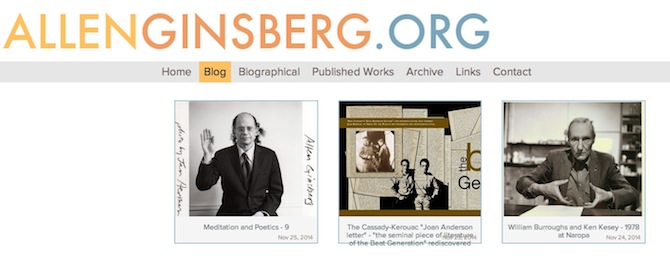I’ve added a site to the blogroll, calling it “All Things Allen Ginsberg” instead of its official web address allenginsberg.org. I should have added it long ago. Bad housekeeping. The site is a goldmine of information, literary and otherwise, not just about Ginsberg, which is its main focus of course, but also about the Beat Generation. This morning the site is using a photo I took in 1980 as the lead-in for its daily blog:

OK, so I’ve buried the lede: The big news yesterday on the Ginsberg site, and elsewhere, via this A.P. story, was the discovery of a long-lost 16,000-word, amphetamine-fueled, stream-of-consciousness letter that Neal Cassady wrote to Jack Kerouac in 1950. It’s being called the “holy grail” of Beat literature and “the most significant literary discovery of the twenty-first century” because, according to the auction house that is putting it up for sale (as part of an archive that it expects to sell for between $300,000 and $500,00), it was “the letter that inspired Jack Kerouac and the entire Beat Generation.”
Holy grail? Holy shit. Maybe it’s the holy snail. The story of its discovery, 60 or so years after it was lost, is more interesting to me than the letter itself. Kerouac once described it as “the greatest piece of writing I ever saw, better’n anybody in America, or at least enough to make Melville, Twain, Dreiser, Wolfe, I dunno who, spin in their graves.” I’d say he was, uhm, exaggerating?
The letter has the self-schooled literacy of the autodidact. Nothing wrong with that. But the notion that it was the greatest piece of writing that Kerouac ever saw probably says more about Kerouac and his reading than it does about Cassady and his writing. I have no patience for the letter’s overwrought, old-fashioned prose. (E.g.: “There are no unexplored paths in my mind and few that are not entangled in the weave of my misery mists. It is but gentle fog thru which I navigate and make friendly by constant intimate communion.”) The archaic style is a would-be writer’s idea of how to write. Cassady asks for “patience with my verbosity.” Sorry. Digression upon digression has no charm for me. And those paths strike me as “but the genteel fog of baloney in the musty mist.”

![Allen Ginsberg in Boulder, Colorado [Photo by Jan Herman, 1980].](http://www.artsjournal.com/herman/wp/wp-content/uploads/2014/11/allen_ginsberg_by_jan_herman260.jpg)
“Beat Baloney in the Mist” ~ a marvelous title for a book or as an instruction for self-gratification.
Cheers, Hammond
Yeah, after the phony trial of Howl/Ginsberg owned the candy store/and if he liked your lollipops/you could come in the back door.. Captain Ferlinghetti cda gone to the judge & said that wuz how sailors talked. He was in ww2/now what you think judge wd do? His brothers were lawyers as well as Ginsy”s bros. They knew Jap bookseller would take the fall if anything happened. Funny how generations of idiot liberals can’t figure out simple politics like idiot son of a Bush/ except to hand each other govt poetry workshop CIA money. Subsidized lent, Weissner called it. Give me the gentle fog to navigate through any day to a faux hobo like Kerouac who had nothing to write about. Har,Har, OMM MOO !
Charles. Plymell
For readers not familiar with the details, the reference to the “Jap bookseller” = Shig Murao. See this website devoted to him:
http://www.zyzzyva.org/2011/10/03/shig-murao-the-enigmatic-soul-of-city-lights-and-the-san-francisco-beat-scene/
As to “govt poetry workshop CIA money” — characterized by Carl Weissner as “subsidized lint” (haw!) — Allen Ginsberg had a more severe complaint about “FBI poetry” in an interview of mine published back in 1980 in the Los Angeles Times. By now the circumstances behind his complaint are well known. Here’s an excerpt:
“What about all the years of FBI disruption of the New Left and the underground press that used to flourish in the ’60s?”
Ginsberg pulled out a thick report, for which he had done much research. It was to be issued by the American P.E.N. Center in New York, a major writers and editors society that advocates for human rights. The report gave a case-by-case account of the collapse of the underground press that resulted from “FBI-directed harassment.”
He pulled another set of documents from a shelf. They were copies of FBI memos obtained under the Freedom of Information Act. Ginsberg read verbatim from a 1968 Newark FBI memo to the director in Washington “that it might be possible to attach the stigma of informant or government fink to Hayden.” The reference was to Tom Hayden, who was then organizing in the Newark ghetto, and who was subsequently denounced at a press conference by Leroi Jones, the noted poet-playwright, who was a black political leader in Newark.
Jones, who later changed his name to Amiri Baraka, was himself a target of the FBI, which sent forged letters to major New Jersey newspapers denouncing him as “an Uncle Tom pig pretending to be a true Black Panther.”
Ginsberg read from still another 1968 FBI memo: “Certain key leaders must be chosen to become the object of a counterintelligence plot to identify them as government informants. It appears that this is the only thing that can cause the individuals concern.”
Ginsberg offered me the papers for examination. They certainly looked authentic. “Those were the FBI’s own words,” he commented sadly. “Ridicule was the most potent weapon it had, according to their 13-point Counter-Intelligence Program, known as COINTELPRO. It was psychological warfare. Their art was ridicule. Those FBI agents were getting millions of dollars in grants from secret funds to write their poetry, while the real poets were getting jail sentences.”
He didn’t see why the agents should get FBI money for their poetry “when we don’t get FBI money for our poetry,” he said. “I’ve got poetry just as practical as any old FBI poetry.”